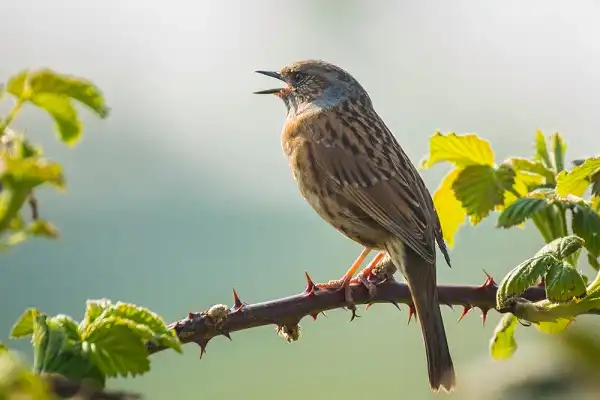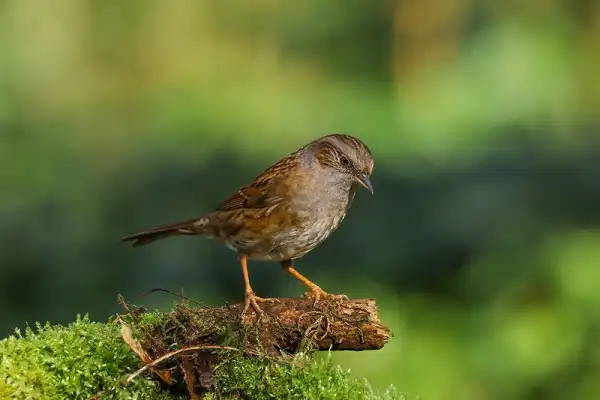Have you ever noticed the small, unassuming grey bird in your garden? It could be a dunnock – an adorable little species of sparrow that is often overlooked in favor of flashier varieties like house martins and bluebirds. Whilst they may not seem as eye-catching and vibrant as other birds, they are just as important to their environment – aiding invertebrates such as earthworms to move food sources around, and helping protect our gardens from insect infestations with the bugs they feed on! In this blog post, we’re going to explore why the humble dunnock is so important for biodiversity and how it can bring beauty and balance into our lives.

Dunnock Description
The dunnock is a small, greyish-brown bird with a slender build and long tail. Its head is dark grey with a white throat, while its chest and belly are light greys or streaked brown. Its wings are short and pointed, and its legs are short and strong. It has a slender bill that can be used to extract insects from foliage and bark crevices. In the breeding season (spring through summer) dunnocks make their presence known with loud calls – they have an impressive repertoire of calls including whistles, rattles, and chirps! Dunnocks often build their nests close to the ground in dense vegetation or amongst rocks where they lay up to five eggs at once. The female typically incubates the eggs whilst the male guards the nest to protect it from predators.
Dunnock Habitat
Dunnocks are found throughout Europe and Asia but are most common in the United Kingdom. They are typically found in woodlands, parks, and gardens, particularly those with dense vegetation that provides ample hiding places for them to hunt invertebrates. Dunnocks prefer habitats with a mix of shrubs, trees, grass, and open areas as this allows them access to food sources such as insects and seeds. In the winter months, dunnocks may move from rural areas to urban ones in search of food, shelter, and nesting sites; however, they normally return to their woodland habitats when spring arrives. Dunnocks will also congregate around bird feeders during the colder months when natural sources of food become scarce. Dunnocks have adapted well to human activity and can be seen flitting between trees on roadsides or along hedgerows in agricultural land or near urban developments. The ability of dunnocks to find suitable habitats in both rural and urban locations has helped these birds survive and thrive over time, despite pressures from human activity such as deforestation or the destruction of natural habitats.

Dunnock Diet
The dunnock has an omnivorous diet, meaning they will feed on both plants and animals. Invertebrates make up the bulk of their diet; they are especially fond of spiders, flies, beetles, bugs, caterpillars, and other larvae. Dunnocks also supplement their diet with a range of fruits and seeds for additional nutrition. In the spring and summer months when the breeding season arrives, dunnocks become more active in their foraging behavior as they need to provide food for their young. They typically take advantage of their short bills to probe for food in crevices in foliage and bark. Dunnocks may also feed on carrion that they find during their food search. Whilst dunnocks primarily use insect prey as a source of sustenance during the spring and summer months, when winter approaches they may move from rural areas to urban ones in search of food. This is because natural sources of insects can become scarce during colder months so dunnocks often take advantage of bird feeders or scavenge for scraps near urban developments to supplement their diets.
Dunnock Size
Dunnocks are small birds, measuring between 11-12 cm in length and weighing around 16-22 grams. They have a slim body shape and long legs, with a distinctive reddish-brown color on their wings and tail feathers. The head of a dunnock is greyish in color with darker brown stripes along the sides. Its bill is short but pointed, allowing it to feed on small insects such as spiders, flies, and beetles. The size of dunnocks makes them incredibly agile flyers, allowing them to perform intricate maneuvers amongst dense vegetation in search of food. This agility also helps them evade any predators that may be lurking nearby! Dunnock nests are often well hidden within dense shrubs or trees; this is to help keep the young safe from predators as well as provide protection from cold temperatures during the winter months.
Dunnock Lifespan
The average lifespan of a dunnock is three to five years, with some individuals living up to 7 or 8 years. The oldest recorded dunnock was nine years and four months old. The oldest recorded female dunnock was 7 years old and the oldest recorded male was 8 years old. In general, males tend to live slightly longer than females due to their larger size, allowing them to better defend against predators and access more resources. Dunnocks are very resilient birds with high levels of adaptability; they can adjust their behavior according to environmental changes and can survive in temperatures as low as -20°C. This ensures that they can survive through even the most extreme winter conditions. Dunnocks are also known for their longevity in terms of breeding activity. They begin breeding from the age of one year onwards and often continue until their death. This means that a single pair of dunnocks have the potential to produce up to 20 or 30 chicks each year!

Dunnock Behavior
Dunnocks display a variety of behavior, both in terms of foraging for food and interacting with other birds. During the breeding season, dunnock pairs tend to display strong pair-bonding behavior where they will remain faithful to each other for several years. This bond helps them to defend their territory and protect their young from potential predators. In addition to this, dunnocks are also known to be cooperative breeders, meaning that they will often share parental duties such as incubating eggs and feeding chicks with other family members or even unrelated birds. This allows them to raise more chicks than if they were on their own, increasing their chances of reproductive success! When it comes to feeding behaviors, dunnocks are quite adaptable in terms of what they consume; they will eat almost any type of small insect or invertebrate, as well as some fruits and seeds when available. They also typically feed in flocks to maximize their efficiency – one bird will act as an ‘early warning system’ to alert the others if there are any potential predators nearby! Finally, dunnocks demonstrate some interesting social behaviors when interacting with other birds.
Dunnock Speed
Dunnocks are relatively agile birds that can fly at speeds of up to 40 kilometers per hour (25 mph). During the breeding season, dunnocks can maintain a top speed of 50 km/hr (30 mph) when they’re in pursuit of food. Despite their size, dunnocks are also capable of performing impressive aerial stunts including hovering and flying backward. They also have excellent maneuverability, allowing them to make quick turns and flips as they navigate complex environments. When it comes to foraging for food, dunnocks rely on their agility and speed to quickly capture prey such as insects or berries. They use rapid acceleration and sharp directional changes to surprise and outmaneuver any potential predators. In addition to this, dunnocks have keen eyesight which enables them to spot potential food sources from afar. Overall, dunnocks are fast-flying birds with remarkable agility and maneuverability which gives them an advantage when hunting for food or avoiding predators. Their impressive speeds allow them to quickly escape danger or pursue prey with ease – making them an important part of many ecosystems!

Dunnock Hunting
Dunnocks are some of the most skillful hunters in the bird kingdom, relying on a combination of speed, agility, and keen eyesight to capture their prey. Dunnocks typically hunt for small insects or berries, stalking their prey from a distance before swooping down with lightning-fast reflexes. In addition to this, dunnocks have also been known to employ sophisticated hunting tactics such as flying backward to surprise their prey. When hunting, dunnocks rely heavily on their sharp vision and acute hearing to detect potential food sources. They will often sit quietly in trees or bushes while scanning the area for any movement that may indicate the presence of an insect or small mammal. Once they spot something they are interested in, dunnocks will quickly change direction and fly toward it at high speeds. Additionally, dunnocks use their wings to generate air turbulence which helps them create a ‘vacuum’ effect around the target – allowing them to trap insects more easily. This technique is also used by other birds such as swallows and swifts, showcasing the incredible adaptability of these avian predators!
Conclusion
Dunnocks are small but mighty birds with some truly remarkable abilities. From forming strong pair bonds during the breeding season to cooperative breeding and even submission bowing when interacting with rivals, dunnocks have a variety of fascinating behaviors that make them one of the most beloved birds in many ecosystems. In addition to this, their impressive speed and agility allow them to outrun predators or capture prey with ease – making them an invaluable part of many different environments. Overall, dunnocks are incredible creatures that deserve our admiration and respect. So next time you spot one of these amazing little birds, take a moment to appreciate its beauty and marvel at its intelligence – it’s sure to be worth it!
Frequently Asked Question

